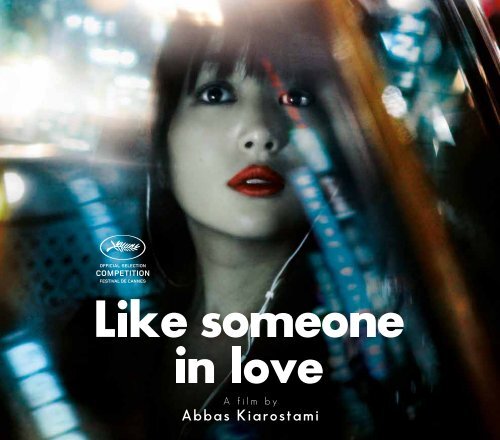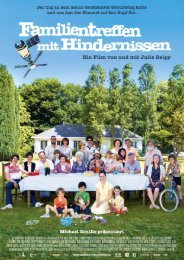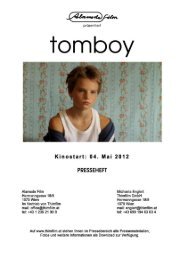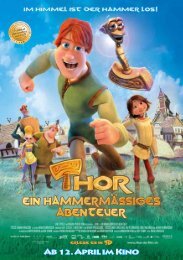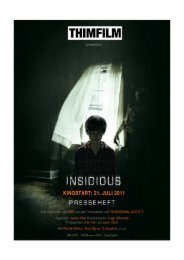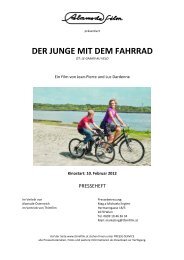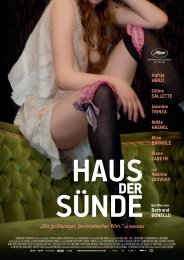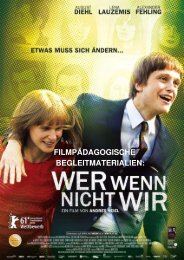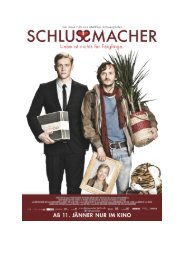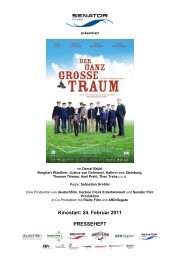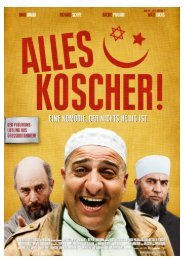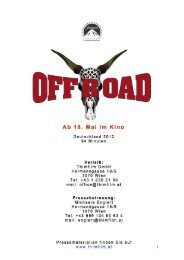Abbas Kiarostami - Thimfilm
Abbas Kiarostami - Thimfilm
Abbas Kiarostami - Thimfilm
- No tags were found...
Create successful ePaper yourself
Turn your PDF publications into a flip-book with our unique Google optimized e-Paper software.
newawakeningWithout doubt, there was an underlying sense of gnawing depravity that surfaced inCertified Copy and took me by surprise. I was sure that I already had a good understanding of thework of this film-maker that I have been lucky enough to come across so often in the past 25 years.So I was not expecting his latest film to outstrip the already high opinion I have of his work. Some peoplelike to feel that they can describe and pigeonhole his films as ‘pseudo-simplistic modernism’. But <strong>Abbas</strong>’films have never failed to surprise and now here, not for the first time, is a new wake-up call, for me,and I am sure many others. With this film, <strong>Abbas</strong> propels his filmmaking into another dimension.6Like Someone In Love dissects the very spirit of human beings, delves into their most private feelings,feelings that even they are unaware of and reveals the fate that inextricably takes hold of each one ofthem. A fate that seems to have swept them all up on the same high-rolling wave, before spitting themout, naked and frozen. I had already felt this tide of emotion when reading the pages of Alfred Hayes.His words could have swallowed me up, swept me away and dragged me off course. They frightenedme, and the more I was gripped by fear, the more lucid I became. I should also mention the black lightwith which Carco thought he could spectrograph his characters’ inner life and the life around them.The more feelings of fear and lucidity come to the fore in films such as Like Someone in Love, the moreopaque and mysterious the film becomes, in a similar way to the lesser known films of Jacques Tourneur,They All Come Out, Circle of Danger, The Fear Makers. Such subtle and clever film-making all showsthe almost intangible uniqueness of their director.Like Someone in Love is an outstanding example of “mise-en-scene”, an almost forgotten art incinematography that has gradually been replaced by different aesthetic values. Here, one is remindedof the masterful skill of Preminger, at the height of his career, but Like Someone In Love is not just a showof masterful craftsmanship. The film is concrete, physical and profoundly enigmatic.One leaves the cinema knowing a little bit more about life.<strong>Abbas</strong>, I did not see this film coming, I thank you and I know others will too…Pierre Rissient, 25 th April 2012Assistant director on Godard’s Breathless, publicist, producer, director, artistic advisor for Cannes festival and black-listedduring McCarthysm, Pierre Rissient is a very influent person in international cinema. He introduced Asian movies to the worldin the 1970s and spotted talents such as Jane Campion and Clint Eastwood (as a filmmaker). In 2002, UNESCO awardedRissient with the Fellini Medal as a tribute to a major figure in the film industry, and his “notable efforts to boost the art offilm”. In 2012, he received le Mel Novikoff Award.7
Back then I asked him why he wanted to make a film in Japan and thiswas his reply:- “Well, because if I make a film in Japan I won’t be accused of makinga film for the West. Making a film in Japan is like making a film in Iran.Whether actors speak Japanese or Persian, there are still subtitles.”This conversation is a good introduction to one important aspect in ourrelationship: language. Or to be more precise, the spoken word. I don’tspeak English. He doesn’t speak French. I don’t speak Persian. So how dowe communicate? This is something quite miraculous and very interesting.It is also a theme in the film Like Someone In Love. Sometimes, we traveltogether without an interpreter and we manage to understand one another.How? I speak to him in French rather slowly, and he speaks back to me inEnglish. I manage to understand his English and he manages to understandmy French. Specially when we are in a car together and I’m driving.He sits next to me, and we speak to each other. We can communicatewith each other because the relationship we have is based on more thanjust words. The words carry information but they also carry an intention,something along the lines of a mutual understanding, a universal language.The situation was the same when working with the filmmaker Kieslowski.I didn’t speak Polish. He didn’t speak French. So I spoke bad Englishand he spoke bad English…..With him, our conversations never tookplace in the car, but in bars, where we would drink together, and itworked. I found the very same universality that goes beyond the barrierof language. I’m not talking about a common language like Esperanto,it goes further than that, it is about being on the same wavelength.On Certified Copy, I remember we were working as we often did at theediting desk, just after the first run through. I commented on a sequencethat I felt was a bit long. He cut it out and I suddenly realised that this wasnow a different film. The 30 seconds that had been taken out changedthe film and changed the language. It changed <strong>Abbas</strong>’ style and hiscinematographic vocabulary: by introducing an ellipsis and omitting aportion of the sequence of events, we were giving emphasis to somethingthat shouldn’t be in the film at all. Certified Copy followed continuity inspace and time, like a long take. He purposefully cut out the sequence infront of me, thinking that maybe I was right, but it was clear that he wasright and I was wrong. It was this kind of thing that contributed to ourunderstanding of each other.What I find fascinating about <strong>Abbas</strong> is that he is always moving forward. His work is constantly evolving.This is the characteristic of a great artist. He approaches each film very differently to the last. When hemade Ten it corresponded to the arrival of the digital camera. For me, Ten is the first film that manages tocombine new digital technology with the subject in a coherent way. Breathless did the same in 1960 withthe revolutionary arrival of the hand-held camera, synchronised sound and carefully planned lighting.There was a link between new technology and Godard’s new way of writing. In the same manner,<strong>Abbas</strong> <strong>Kiarostami</strong> is one of the only filmmakers to have taken advantage of new digital technologyfor his mise-en-scene.For <strong>Abbas</strong> <strong>Kiarostami</strong>, the issue when making Like Someone In Love was not to forget himself once outsideof Iran. This was of great concern to me. I think that every artist is deeply rooted in the reality of his owncountry, but at the same time we expect them to be universal. One foot in, one foot out. How could wehelp prevent him from losing his way? How could he remain true to himself? He managed to achieve thiswith Certified Copy which is why I found it so surprising that the Americans and the Brazilians felt that itwas an Iranian film above all else. After having worked with a famous actress such as Juliette Binoche, forLike Someone In Love, he chose to work with newcomers, one of whom was 80 years old and the other20! By doing this, he was experimenting further with artistic expression and the complexity of relationships.Making his film in Japan forced him to write a script, a text. This created a distance between <strong>Kiarostami</strong>and his film, and a distance between himself and Iran. It automatically gave him the status of foreigner,which enabled him to get to the essence of the film more directly.There is a very interesting theme in Like Someone In Love that is worth exploring, the theme of reflections.Reflections create backdrops, new spaces, surprising mirrored images. I watched him work and take thetime to register the reflection of the stand-ins as they passed by. Working directly with the actors turnedout to be quicker than working with the stand-ins. A director experimenting with classic cinematographictraditions can be very trying for the film crew. There were regular run-ins during the early stages offilming. This working method also required readjustments to be made by the production team. We arecapable of becoming lazy, and never questioning our working methods. But <strong>Abbas</strong> <strong>Kiarostami</strong> is like analarm bell that wakes you up in the morning. It might not be pleasant, but you have to jump. Without him,I would be asleep! A Japanese film, produced in France has never been tried before. As Arte turneddown the film, I didn’t have enough money to produce it, even with the contribution from the Japaneseproducer. But I had promised <strong>Abbas</strong>. So I took a very beautiful Yves Klein sponge sculpture that I cherishalong to Sotheby’s who sold it for me in auction in the States. With the proceeds of the sale, I was ableto make <strong>Abbas</strong> <strong>Kiarostami</strong>’s film. I am happy to have swapped a beautiful piece of work by Yves Kleinfor a beautiful piece of work by <strong>Abbas</strong> <strong>Kiarostami</strong>.Just the other day I said to him:- “Who will you do your next film with?” He looked at me slightly taken aback.- “Well… with you of course. You are my only producer.”- “I’m so pleased, because you are my only director.”10 11
In productionwith <strong>Abbas</strong> by Kenzo HorikoshiI watched <strong>Abbas</strong> <strong>Kiarostami</strong>’s Close-Up for the first time in 1991, at the Yamagata Documentary FilmFestival, and I was impressed by its meticulous and delicate character. Ever since, for 20 years, I havedistributed his films in my little cinema theater as well as in other arthouse cinemas in Japan.In 1993 we picked up the very first Iranian film to be distributed commercially in Japan.Where Is The Friend’s Home? had a documentary nature, but managed to touch a large audience,struck by its simplicity while still making a strong impression. Akira Kurosawa saw the film and sent us histhoughts: «I would have loved to have directed such a film.»During the years to come, <strong>Abbas</strong> <strong>Kiarostami</strong> regularly travelled to Japan to promote his films and toattend the Japanese Film Festival.In 2004, he was granted the Praemium Imperiale (an arts prize, annually awarded on behalf of theJapan Art Association) and, upon his visit to Japan to attend the ceremony, he asked to be introduced toan elderly lady, an extra, and requested a video camera as well as a car, to use for film tests. Everythingwas ready according to his requests. We went to Roppongi, central Tokyo’s entertainment district, for thefilm tests. At the time you could often see posters with pictures of call girls in phone booths. <strong>Kiarostami</strong>asked the elderly woman to go to a phone booth and bring back a photo of a call girl. That’s when hestarted to shoot.In the following scene, the same woman stood waiting at the corner of a busy street. Following hisdirectives, the car passed by, observing the woman, while <strong>Kiarostami</strong> was shooting from inside the car.Later, this would become the key scene in the first half of Like Someone In Love and the idea for the filmwas born from this scene.In 2010, at the press conference for Certified Copy in selection at the Pusan Film Festival <strong>Kiarostami</strong>suddenly announced, to my great surprise, that his next film would be shot in Japan.One month later, <strong>Kiarostami</strong> began casting for his film in Tokyo!As soon as it became known that the Palme d’Or award-winning director <strong>Abbas</strong> <strong>Kiarostami</strong> was castingfor a film to be shot in Tokyo, a large number of acclaimed and famous actors lined up to meet withhim. Among them, some were determined to play the lead roles and subsequently the film financing wentsmoothly. With pre-production underway, we planned for the production to start end of March 2011.But then disaster struck. On March 11, Japan was hit by the mostpowerful earthquake it had experienced since 1900 and the tsunamicaused considerable damage to the country’s East Coast. From then on,all films in production, including ours, were interrupted or held back untila future date. The financing partners abandoned all their film projects.Hoping to for a fresh start in May, we realized that our lead actorswere no longer available for rehearsals. Once again, we had to setup a new casting process. After a few months of casting, the ensemblewas finally confirmed, and apart from the actor Ryo Kase, none of thelead actors were known to film fans. <strong>Kiarostami</strong>’s remarkable intuitionallowed us to lock down a cast, in line with the characteristic cast ofhis films.The production finally got under way on October 30 2011beginning with the first scene of the screenplay written by <strong>Kiarostami</strong>:FIRST SCENE - CAFÉ - NIGHT TIME.But again we suffered a setback. A couple of days later, all the extraswere replaced and the scene was shot again. As expected, <strong>Kiarostami</strong>’sdirection was completely unique. He would not allow the actors toread the entire screenplay. Every day, the details of the scene to beshot the following day were revealed to the actors. They did not knowtheir characters’ role in the story, nor did they know how the film ends.To know the end of the story and the fate of the characters couldlead to the actors counter-performing, a sort of «performance with adowngrading effect».I don’t believe that <strong>Kiarostami</strong> is limiting the actor’s liberty, but that he12 13
elieves that everyday life should reflect in a film and in our everydaylife we have no idea of what will happen to us tomorrow or with whomwe will fall in love. In fact, it seemed to me that the actors who wantedto know the fate of the character they would portray, were determinedto relinquish that knowledge, their worries did fade away and theyvery quickly started enjoying «life» naturally in front of the cameras.As the producer, I should have understood long ago, that <strong>Kiarostami</strong>’sfilms are not tinged documentaries. He plants trees along streets,he expands houses, transforms the walls in another person’s home in onesimple turn and gives subtle attention to every aspect of the framing ofthe screen. He configures reality, really.Even I, as an admirer of his films, did not realize that the hidden realitybehind this «zig-zag path» of his was in fact part of his unique work,as a result of months of work.On December 4, the production wrapped with the scene where Noriaki(Ryo Kase) realizes what is about to happen at the old professor’s homeand ferociously pounds on his apartment door. We had a wrap party.But a few weeks later, <strong>Kiarostami</strong> wanted to plan a new scene withNoriaki.The actor, Ryo Kase, had by then already committed to another filmand was in the middle of shooting it. We had to wait for his beardto grow. We waited and waited. Finally, his beard grew back to thelength of Noriaki’s beard in the film and when the production finallywrapped for good, it was already Christmas.1415
<strong>Abbas</strong><strong>Kiarostami</strong>Biography<strong>Abbas</strong> <strong>Kiarostami</strong> was born on 22 June 1940 in Tehran, Iran. He showed a keen interestin drawing early on and, at age 18, entered a graphic-art contest and won. He studied at thefine arts school in Tehran whilst making ends meet as a graphic designer, poster illustrator andcommercial ad director. In 1969, he founded the cinema department of the Institute for theIntellectual Development of Children & Young Adults, which is also where he directed his first shortfilms.In his first film, The Bread and The Alley (1970), <strong>Abbas</strong> <strong>Kiarostami</strong> explores the weight of images andthe relationship of realism and fiction. His preferred theme, the universe of childhood, is expressedover a long series of short, medium length and feature films, during which he has managed toestablish a subtle balance between narrative and documentary style. Homework (1989), his lastchildhood film, is a good example of warm and poetic cinema that discreetly denounces the heavyaspects of Iranian society.With Close-Up (1990), he turned a page. In less than one week, the director embraced a news storyand, with the participation of the real life protagonists, made it a pretext to introduce reality intothe realm of fiction. Life And Nothing More (1992) and Through The Olive Trees (1994) completea trilogy that began with Where Is My Friend’s House? (1990). In the latter, the devastating effectsof an earthquake in northern Iran serve to uncover the lie that is cinema.Taste Of Cherry (1997) marked the director’s coming into his own, and his entry into the ranks ofaward winners. The film, which tells the story of a 50-year-old man’s obsession with suicide, is anode to individual freedom. The film was praised by critics and denounced by religious authorities inIran. A slow and contemplative pace, limited intrigue, and references to Persian poetry and Westernphilosophy are the trademarks of this deeply original director’s work. His taste for improvisationis grounded in loosely written scripts, amateur actors, and his own editing. The Wind Will CarryUs (1999), the story of a group of city dwellers who go to find something in a rural village,is yet another example of his unique style. The film was also his first creative collaboration withMarin Karmitz and MK2.Since 2001, <strong>Kiarostami</strong> has been involvedin a love affair with a small camera and, asa result, works only with digital film. He hasgained more freedom with this «camerapen»of his and has with its help, directedseveral nature films of varying lengths,between fiction and documentary: ABCAfrica (2001), Ten (2002), Five DedicatedTo Ozu (2003), 10 on Ten (2004), Roads of<strong>Kiarostami</strong> (2005) and Shirin (2008).With Certified Copy in 2009, <strong>Kiarostami</strong>comes back through fiction to a biggerproduction and shoots for the first time outof Iran - in Tuscany - with an internationalcast. Juliette Binoche will receive the BestActress award during Cannes Festivalwhere the film was presented in the OfficialCompetition.After Italy, Like Someone In Love, aproduction similar to Certified Copy, brings<strong>Abbas</strong> <strong>Kiarostami</strong> to Japan, a new universeto discover.1617
Filmography182012 LIKE SOMEONE IN LOVE Cannes 2012: Official Selection - In Competition2010 CERTIFIED COPY (original title: Copie conforme)Cannes 2010: Best Actress award for Juliette Binoche2008 SHIRIN2007 WHERE IS MY ROMEO?Segment from the collective film TO EACH HIS OWN CINEMAdirected for Cannes 60th Anniversary4 video letters to Victor Erice2005 CORRESPONDANCESROADS OF KIAROSTAMITICKETS segment from the film COLLECTIFdirected by <strong>Abbas</strong> <strong>Kiarostami</strong>, Ermanno Olmi and Ken Loach2004 10 ON TENFIVE Dedicated to Ozu2002 TEN2001 ABC AFRICA1999 THE WIND WILL CARRY US (original title: Baad ma ra khahad bord)Venice 1999 : Jury Grand Prix, International Critic’s Prize by the FIPRESCI1997 TASTE OF CHERRY (original title: Tam’e Guilass)Cannes 1997: Palme d’OrBIRTH OF LIGHT1995 AN EGG (UN OEUF) segment from the film LUMIERE AND COMPANYREPÉRAGES segment from the film À PROPOS DE NICE, LA SUITE…1994 THROUGH THE OLIVE TREES (original title: Zir-e derakhtan-e zeytoun)1992 LIFE AND NOTHING MORE... (original title: Zendegi edamé dârad)…1990 CLOSE-UP (original title: Nema-ye Nazdik)1989 HOMEWORK (original title: Mashgh-e Shab)1987 WHERE IS MY FRIEND’S HOME?(original title: Kaneh-ye doust kojast ?)1984 FIRST GRADERS (original title: Avali ha)1983 LE CONCITOYEN1982 THE CHORUS (original title: Hamsarayan)1981 ORDERLY OR UNORDERLY(original title: Be tartib va bedoun-e tartib)1980 DENTAL HYGIENE(original title: Behdasht-e Dandan)1979 FIRST CASE, SECOND CASE(original title: Ghazieh-ye shekl-e aval,Ghazieh-e shekl-e dovom)1978 SOLUTION N O 1 (original title: Rah-e hal-e yek)1977 TO PAINT episode from HOW TO MAKE USEOF OUR LEISURE TIME?(original title: Az Oghat-e Faraghat-e KhodChegouneh Estefadeh Konim?)THE REPORT (original title: Gozarech)TRIBUTE TO THE TEACHERS(original title: Bozorgdasht-e mo’Allem)1976 THE COLOURS (original title: Rang ha)A SUIT FOR WEDDING(original title: Lebassi baraye aroussi)1975-1979 JAHAN-NAMA PALACE1975 SO I CAN (original title: Man ham mitounam)TWO SOLUTIONS FOR ONE PROBLEM(original title: Dow rahe hal baraye yek massaleh)1974 THE TRAVELER (original title: Mossafer)1973 THE EXPERIENCE (original title: Tadjrobeh)1972 THE BREAKTIME(original title: Zang-e tafrih)1970 THE BREAD AND ALLEY(original title: Nan va koutcheh)19
RinTakanashiBorn in 1988, Rin Takanashi started her activity as an actress withGoth in 2008.In 2009 she played in Samurai Sentai Shinkenger, an action TV serieswhere she featured as one of the main characters.Her next feature film is Is There Anyone Alive? directed by Gakuryu Ishii.Her other works are TV drama Space Dog Strategy, O Parts, Papadorand some more.This year she has also played in Today, Love Will Start directed byKen Furusawa, scheduled to be released in December 2012.2021
TadashiOkunoTadashi Okuno was born in 1930. He has started his activities in hisearly 20s as a play actor with Bungakuza, a famous play group andtheatre.Later he played as supporting actor in a few TV dramas and movies.2223
RyoKaseBorn in Kanawaga in 1974, Ryo Kase lived in Washington until theage of seven.His cinema career began in 2000 in the legendary action film Gojoeby Sogo Ishii and in the comedy Party 7 by Katsuhito Ishii. In 2001 hewent on to act in Godzilla, Mothra And King Ghidorah: Giant MonstersAll-Out Attack by Shusuke Kaneko.Ryo Kase has since been in over 40 films, as well on television and inadvertisements.Most of his films have never made it to European cinemas. Films suchas Antena by Kazuyoshi Kumakiri (2004), Scrap Heaven by Sang-il Lee(2005), I Just Didn’t Do It by Masayuki Suo (2006) and The Invitation FromCinema Orion by Kenki Saegusa (2008).However, the French cinema-going public discovered him in 2001 inthe romantic comedy Hush by Ryosuke Hashiguchi and later in KiyoshiKurosawa’s dramas Jellyfish (2003) and Retribution (2007), in NobodyKnows (2004) and Hana Yori Mo Naho (2006) by Hirokazu Kore-eda,The Taste of Tea by Katsuhito Ishii (2004), and in Outrage by TakeshiKitano (2010).Kase has also had parts in international films such as The Passenger byFrançois Rotger (2005). He played the part of Shimizu in Clint Eastwood’sfilm Letters from Iwo Jima (2006).He did the voice-over for one of the characters in The Sky Crawlersby Mamoru Oshii (2008).He is a ghost in Restless by Gus Van Sant (2011) and Akira inInterior Design, Michel Gondry’s segment in the film Tokyo! (2008).2425
MarinKarmitzA selective filmography among the 110 filmsproduced and co-produced since 19771977 PADRE PADRONE by Paolo and Vittorio TavianiCannes 1977: Palme d’Or 1980A LEAP IN THE DARK by Marco BellocchioCannes 1980 : Best Actress award for Anouk Aimée,Best Actor award for Michel Piccoli1981 LOOKS AND SMILES by Ken LoachCannes 1981 : International Critic’s Prize by the FIPRESCIEVERY MAN FOR HIMSELF by Jean-Luc GodardCannes 1981 : Official SelectionCésar 1981 : Best Actress award in a Supporting Role for Nathalie Baye1982 Yol by Yilmaz GüneyCannes 1982 : Palme d’OrTHE NIGHT OF SAN LORENZO by Paolo and Vittorio TavianiCannes 1982 : Jury Grand PrixMOONLIGHTING by Jerzy SkolimowskiCannes 1982 : Best ScreenplayHALF A LIFE (MOURIR À TRENTE ANS) by Romain GoupilCannes 1982 : Directors’ Fortnight: Golden Camera and Youth PrizeCésar 1983 : Best First Film1985 COQ AU VIN by Claude ChabrolCannes 1985 : Official SelectionCésar 1986 : Best New Comer nomination for Lucas Belvaux1986 THE BEEKEEPER by Theo AngelopoulosVenise 1986 : Official Selection Out of CompetitionMElo by Alain ResnaisVenise 1986 : Official Selection Out of CompetitionCésar 1987 : Best Actress award for Sabine Azéma,Best Actor in a Supporting Role award for Pierre ArditiNew York 1987 : Official Selection26 27
1987 GOODBYE, CHILDREN (Au revoir les enfants) by Louis MalleVenise 1987 : Golden LionOscar 1987 : Nominated for Best Screenplay and Best Film in a Foreign LanguageCésar 1988 : Best Film, Best Director, Best Original Screenplay, Best Cinematography,Best Editing, Best Sound, Best Set Design1988 Chocolat by Claire Denis Cannes 1988 : Official SelectionSTORY OF WOMEN by Claude ChabrolVenise 1988 : Best Actress award for Isabelle HuppertGolden Globe 1989 : Best Film in a Foreign Language1989 LIFE IS A LONG QUIET RIVER by Etienne ChatiliezCésar 1989 : Best Film, Best Original Screenplay,Best Newcomer award for Catherine JacobI want to go home by Alain Resnais Venise1989 : Best Screenplay1990 Taxi Blues by Pavel LounguineCannes 1990 : Best DirectorGolden Globe 1990: Best Film in a Foreign Language1991 Madame Bovary by Claude ChabrolMoscow 1991: Best Actress award for Isabelle Huppert1993 Mazeppa by Bartabas Cannes 1993 : Official SelectionGolden Camera Special DistinctionTHREE COLORS: BLUE by Krzysztof KieslowskiVenise 1993 : Golden Lion, Best Actress award for Juliette Binoche, Best PhotographyCésar 1994 : Best Actress award for Juliette Binoche, Best Sound, Best Editing1994 THREE COLORS: WHITE by Krzysztof KieslowskiBerlinale 1994 : Silver Bear, Jury Special PrizeTHREE COLORS: RED by Krzysztof KieslowskiCannes 1994 : Official SelectionMéliès Prize 1994 : Best French FilmOscars 1995 : Nominated for Best Director, Best Screenplay, Best PhotographyAN UNFORGETTABLE SUMMER by Lucian Pintilie Cannes 1994 : Official Selection1995 A JUDGEMENT IN STONE by Claude ChabrolVenise1995 : Best Actress award for Isabelle Huppert and Sandrine BonnaireCésar 1996 : Best Actress award for Isabelle Huppert1996 Too late by Lucian Pintilie Cannes1996 : Official SelectionGabbeh by Mohsen Makhmalbaf Cannes 1996 : Official Selection, Un Certain RegardDEEP CRIMSON by Arturo Ripstein Venise 1996 :Best Screenplay, Best Music, Best Set Design1997 THE SWINDLE by Claude Chabrol San Sebastian1997 :Best Film, Best Director1998 THE APPLE by Samira Makhamalbaf Cannes1998 : Un Certain Regard Golden CameraNEXT STOP PARADISE by Lucian Pintilie Venise 1998 : Jury Grand Prixthe Silence by Mohsen Makhmalbaf Venise 1998 : Prix d’Or du Sénat1999 COLOUR OF LIES by Claude Chabrol Berlin 1999 : Official SelectionTHE WIND WILL CARRY US by <strong>Abbas</strong> <strong>Kiarostami</strong> Venise 1999 : Jury Special Prize2000 CODE UNKNOWN by Michael Haneke Cannes 2000 : Official SelectionNIGHT CAP by Claude Chabrol Louis Delluc Prize 20002001 THE PIANO TEACHER by Michael HanekeCannes 2001 : Grand Prix, Best Actress award for Isabelle Huppert,Best Actor award for Benoît MagimelCésar 2002 : Best Actress in a Supporting Role award for Annie GirardotABC Africa by <strong>Abbas</strong> <strong>Kiarostami</strong> Cannes 2001: Official SelectionOut of Competition2002 Ten by <strong>Abbas</strong> <strong>Kiarostami</strong> Cannes 2002 : Official Selection2004 WOMAN IS THE FUTURE OF MAN by Hong SangsooCannes 2004 : Official Selection2005 TALE OF CINEMA by Hong Sangsoo Cannes 2005 : Official Selection2007 Paranoid Park by Gus Van Sant (Associate Producer)Cannes 2007 : 60 th Anniversary Prize2009 SUMMER HOURS by Olivier Assayas (Associate Producer)Best Film in a Foreign Language for the New York Film Critics Circle Awards,the Boston Society of Film Critics, the Los Angeles Film Critics Association andthe Southeastern Film Critics Association 20092010 CERTIFIED COPY by <strong>Abbas</strong> <strong>Kiarostami</strong> Cannes 2010 :Best Actress award for Juliette Binoche2012 Like Someone in Love by <strong>Abbas</strong> <strong>Kiarostami</strong>Cannes 2012 : Official Selection - In CompetitionON THE ROAD by Walter Salles (Associate Producer)Cannes 2012 : Official Selection - In CompetitionSomething in the air by Olivier Assayas (Associate Producer)(in post-production)2829
30EurospaceKenzo HorikoshiFilmographyKenzo Horikoshi is a producer and a professor at the Tokyo University of the Arts. He graduated fromthe School of Film and New Media. He is now Head of Eurospace Inc. and of the Film School of Tokyo(Eiga-bigakko).In 1977, Kenzo Horikoshi started in the movie industry by owning a film club.In 1982, he founded Eurospace, one of Tokyo art house distribution pioneers, and released more than 140films. Since 1992, he has produced and co-produced about 20 long-featured films. In 1997, he openedthe Film School of Tokyo and in 2005 he created a PhD in cinema at the Tokyo University of the Arts.ProductionI’ve Heard the Ammonite Murmur by Isao YamadaT-City by Saburo TeshigawaraKosh Ba Kosh by Bakhtijar Khudojnasarov Angel Dust Réalisation Sogo IshiiANGEL DUST by Sogo IshiiSmoke by Wayne WangThe Written Face by Daniel SchmidTokyo Eyes by Jean-Pierre LimosinPOLA X by Leos CaraxCRIMINAL LOVER by Francois OzonLuna Papa (aka MOON FATHER) by Bakhtijar KhudojnasarovThe Barren Illusion by Kiyoshi KurosawaWATER DROPS ON BURNING ROCKS by Francois OzonUNDER THE SUN by Francois OzonAcacia Walk by Jouji MatsuokaBridget by Amos KollekSecret Journey by Takahisa ZeZeMAREBITO by Takashi ShimizuSynesthesia by Toru MatsuuraDANIEL SCHMID - LE CHAT QUI PENSE by Daniel SchmidDistributionTHE ENIGMA OF KASPER HAUSERby Werner HerzogKINGS OF THE ROAD by Wim WendersRepo Man by Alex CoxElement of Crime by Lars Von TrierBrother from Another Planetby John SaylesLight Years Away by Alain TannerVideodrome by David CronenbergSUGAR BABy by Percy AdlonFULL MOON IN PARISby Eric RohmerA Zed & Two Noughtsby Peter GreenawayBAD BLOOD by Leos CaraxRed Sorghum by Zhang YimouEpidemic by Lars Von TrierSTREET OF NO RETURN by Samuel FullerBAND OF FOUR by Jacques RivetteTHE LOVERS ON THE BRIDGE by Leos CaraxPoison / SAFE by Todd HaynesTHE MOTHER AND THE WHORE by Jean EustacheSAVAGE NIGHTS by Cyril CollardLIFE, AND NOTHING MORE… by <strong>Abbas</strong> <strong>Kiarostami</strong>The Blue Kite by Tian Zhuang-ZhuangArizona Dream by Emir KusturicaIN THE LAND OF THE DEAFs by Nicolas PhilibertFarinelli by Gérard CorbiauBreaking the Waves by Lars Von TriersKids Return by Takeshi KitanoDRIFTING CLOUDS by Aki KaurismakiTHOSE WERE THE DAYS by Didier HaudepinTASTE OF CHERRY by <strong>Abbas</strong> <strong>Kiarostami</strong>THE RIVER by Tsai Ming-liangSitcom by Francois OzonTHE CELEBRATION by Thomas VinterbergTHE WIND WILL CARRY USby <strong>Abbas</strong> <strong>Kiarostami</strong>RETROSPECTIVE on JEAN EUSTACHEby Jean EustacheWHAT TIME IS IT THERE?by Tsai Ming-LiangTen by <strong>Abbas</strong> <strong>Kiarostami</strong>THE MAN WITHOUT A PASTby Aki KaurismäkiTHE LIGHTS IN THE DUSTby Aki KaurismäkiCERTIfIED COPY by <strong>Abbas</strong> <strong>Kiarostami</strong>Le HAvre by Aki KaurismäkiExecutive ProductionFrank Lloyd Wright and Japanese Artby Keneth LoveFour Seasons (Canadian TV Documentary)Demonlover by Olivier AssayasFEAR AND TREMBLINGby Alain CorneauThe Stratosphere Girl by M.X.ObergMusica Cubana by German KralValley of Flowers by Pan NalinPalm Rain by Frederic FisbachTokyo! by Leos Carax, Michel Gondry,Bong Joon-ho31
CastAkikoTakashiNoriakiHiroshithe neighbourAkiko’s grand motherold studentNagisathe taxi driverthe auto mechanicNagisa’s friendRin TAKANASHITadashi OKUNORyo KASEDendenMihoko SUZUKIKaneko KUBOTAHiroyuki KISHIReiko MORIKouichi OHORITomoaki TATSUMISeina KASUGAIA film written and directed byOriginal ScreenplayThe Grand Mother’s messagesDirector’s Assistant and Interpreter1 st Assistant Director2 nd Assistant Director3 rd Assistant DirectorScript GirlCasting DirectorDirector of PhotographyCamera AssistantsVideo EngineerEditingEditor AssistantSound MixerSound EditingMixSet Designer MasterSet DesignersSet CoordinatorCostume MasterMake-up Master/Hair MasterMake-up Artist/Hair DresserProduction ManagersProduced byAssociate ProducersCrew<strong>Abbas</strong> KIAROSTAMI<strong>Abbas</strong> KIAROSTAMIMohammad RAHMANIShohreh GOLPARIANYuichi TAZAWAKazuki TOBITASatoru HIROHARAEdiShogo YOKOYAMATsuyoshi SUGINOKatsumi YANAGIJIMAShinji SUZUKI, Takayuki MATSUMOTO,Anna TANAKAAkira SEKIGUCHIBahman KIAROSTAMIEdishogo YOKOYAMANobuyuki KIKUCHIReza NARIMIZADEHMohmmadreza DELPAKToshihiro ISOMIEmiko TSUYUKI, Takeshi KANABAYASHI,Ayu HASUIKE, Masato NUNOBE,Nohara ICHIJOYoshihumi HIRAKOMasae MIYAMOTOShinji HASHIMOTOYoshie NAGAKUBOTetsuya NAKAMURA, Ryusuke MIYAMORI,Naoko NAKAMARUOMarin KARMITZ - Kenzo HorikoshINathanaël KARMITZ - Charles GILLIBERT32A France/Japan co-production With the participation of CNCCentre National du Cinéma et de l’Image Animée and of the Agency for Cultural Affairs, Japanese Government33
As with all of <strong>Abbas</strong>’ films, I was expecting something surprising.And the surprise came as soon as the first words were spoken in theJapanese bar: Who is talking? When I found the answer, I let myselfbe carried along, very gently at first, as if gliding, and then sweptalong faster and faster. I forgot where I was. Goodbye Yokohama.Only the characters held me in check. I was sitting next to them,talking to them, I was listening to them. I found myself somewherebetween The House of the Sleeping Beauties and The Art of Beinga Grandfather, between Kawabata and Victor Hugo. Everywhereand nowhere. With each look, each phrase, a surprise, an emotion,all the way through till the end. Some visual details left me confused,like the bracelet on the sofa, but undoubtedly <strong>Abbas</strong> is a bit like me,I suspect that he does not control every detail. We are with <strong>Abbas</strong> ina fog of confusion, where shadows chase each other, where silenceechoes in on itself. He leads us into a place that he is in the processof discovering. Even he does not know all the potential pitfalls.Relinquishing knowing everything about one’s characters is a maturesign of acceptance that the characters are alive.And this all revolves around the fragile, intermittent quality known aslove. Here, love is shown in its natural state. Love is scorned, ignoredand under threat, but indestructible.Jean-Claude CarrièreJean-Claude Carrière is a French writer, director, lyric-writer and script-writer whohas collaborated with famous filmmakers such as Luis Buñuel, Volker Schlöndorff,Louis Malle, Pierre Etaix, Philip Kaufman, Jean-Paul Rappeneau etc. He also played inThe Return of Martin Guerre by Daniel Vigne and more recently in Certified Copyby <strong>Abbas</strong> <strong>Kiarostami</strong>.3435
36CREDITS NOT CONTRACTUAL.


